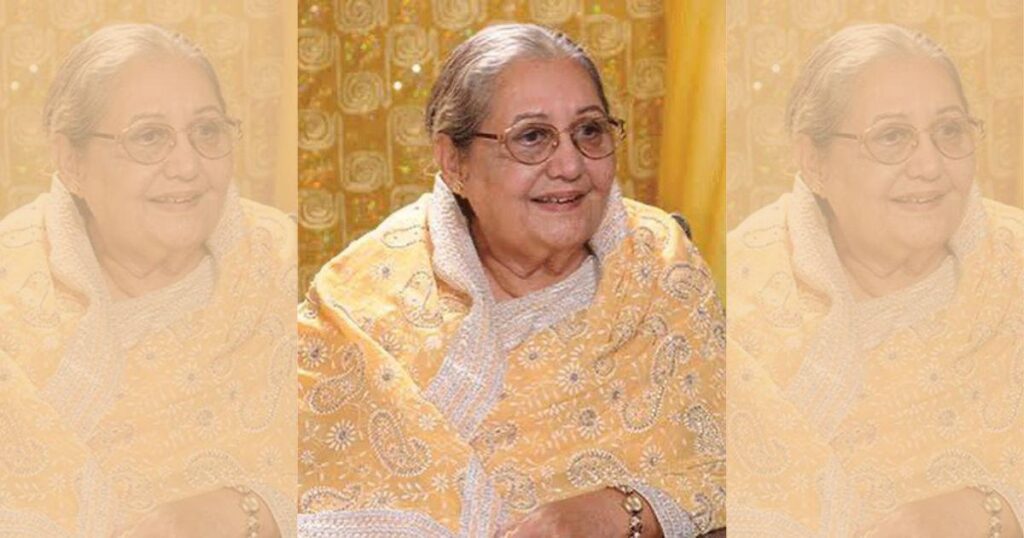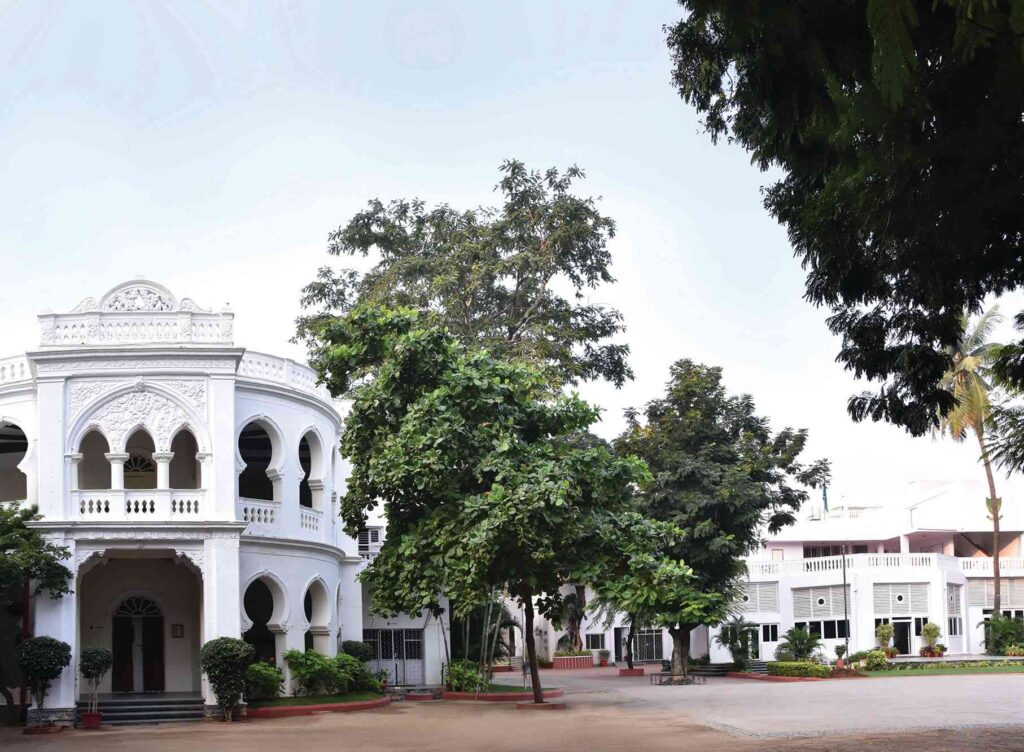Hyderabad, TELANGANA :
Diwali melas, Ramzan fasts and Christmas feasts went together at Hyderabad’s Nasr School. With her passing on August 16, a quixotic idea seems to have died too.

Courtesy Nasr School/Facebook
Once a week around midday, Maulvi Sah’b would come in through the gates of our school in Hyderabad and class would divide briskly into two and troop off to different parts of the building. Those who were Muslim would be at religious instruction classes with him for the next half hour while the others trudged through moral science lessons. Something similar happened during language classes. We would hear a singsong chorus of “A-salaam-aleikum, Aunty”, from the Urdu classroom as we sat at our Sanskrit or Telugu lessons.
Through my nomadic childhood, I’ve been at many schools. None exemplified the idea of secular India as intensely as this Muslim school in Hyderabad. Begum Anees Khan, who made it so, died in Hyderabad on August 16. Her passing feels symbolic, as if it signifies the death of a quixotic idea.
Anees Khan was not given to seeking the limelight or making speeches. She never spelled out her secularism. It was instinctive: instead of words, there was action. Students of different faiths did their namaz or prayers separately, everything else together. Religion was not denied, but it was shown its rightful place.
When we were at Nasr School, we took all of it for granted, never suspecting goals or visions or manifestoes. It seemed natural for us that school should have both namaz and Diwali melas, that our classmates would fast during Ramzan and feast at Christmas. Maybe this is the reason for my rage and incomprehension when people around me casually describe neighbourhoods and towns as having “too many Muslims” in the way people might say “too many mosquitoes”.
It was not an easy act to pull off in the Hyderabad of the 1980s. Communal riots began on the flimsiest of pretexts and fear would ripple through the school. I remember panic-stricken phone calls to car-owning parents, who arrived and carried away groups of girls to drop them home before the riot came too close. The next day, we would return to school as if nothing had happened.
The school was identifiably Muslim: there was a signboard over the main gate with the name of the school, which means “Victory” in Arabic, inscribed below with a line in Arabic from the Koran, that means, “With God’s help victory is near.” Though murderous vigilantes didn’t roam the streets then, as they do now in certain parts of India, it was still a city divided down religious lines. Creating a school like Nasr was an act of wild courage and imagination.
Begum Anees Khan was born into the Muslim aristocracy of Hyderabad, and was an outlier who broke away from the feudal indolence that, according to an insider, characterised this world. Running a business was unheard of, the genteel lived off inheritances. It was in this milieu that Anees Khan began Nasr in 1965 as a small school in her garden. It became a family enterprise where gradually her sister, her husband, her two daughters and her son became involved. (There are now four branches, including a charitable school.)

Courtesy Nasr School/Facebook
My classmate Saira Ali Khan, whose older sister Fauzia was in that first lot of students along with Anees Khan’s youngest daughter, says there were few other English-medium options for girls then. Most schools were convents where Muslims didn’t want to send their children. Because Anees Khan was one of their own, conservative Muslims felt safe enough to send their daughters to Nasr School even though it was not a religious institution, nor was it exclusively for Muslims. In an act of daring, Anees Khan made it co-educational, but perhaps this was the one dream she had to sacrifice. By my time it was all-girls, though some of the teachers were men.
When I joined it in the 1980s, Anees Khan’s own home stood to the right of the school building. This was an old white mansion with an inner courtyard behind the raised entrance, and a playground in front of it. Lines of casuarina trees stood like sentries along the playground, and at the gate was a shack for us to buy deliciacies such as churan and sweets.
Mrs Khan presided over this little empire with the elegance and style that the British queen with her dumpy handbag and hat could only have aspired to. Elahé Hiptoola, a classmate of mine (producer of films such as Hyderabad Blues, Dhanak and Modern Love Hyderabad), has a vivid memory of Mrs Khan’s chiffon saris, her perfume, the remarkable way she exuded authority without ever raising her voice. I remember her telling us to give time and thought to our written signature – it had to make a statement, it was not merely the writing of your name. I wonder now if these were ways in which she had to assert her own identity, with calm firmness, within her deeply conservative world.
Reconciling differences in the school must have taken a great deal of effort for Anees Khan. A few of my classmates arrived in burqas, which they swiftly shed to reveal our standard-issue olive-green tunics or the white sports uniform. There were great disparities in income levels – many students were from landed, feudal families, while others came from humbler backgrounds. There was much swapping at lunch between tiffin-boxes containing venison, dry fruits, and salan, and those with parathas or idlis.
To make sure everyone could afford the school, fees were kept absurdly low, exercise books and stationery were free. Textbooks were handed down from one class to the next until they fell apart from doodles and grease. Even those who could afford new books had to have used ones. Each of us had a desk with a lock and key and we had to leave our books at school, carrying home only the ones we needed.
I now marvel at the imaginative ways by which Mrs Khan taught us to be spirited and daring, to look after our possessions, start small businesses, care for animals, and most of all, enjoy life. During the cool months, classes were cut in half and you could do what you pleased – provided you actually did something, such as painting or gardening or acting.
She made us start a plant nursery, look after animals such as rabbits and geese, collect money and cook food to sell during the Diwali melas. The teachers were given a free hand and some, like Chandra Dorai, our brilliant English teacher, spent whole afternoons making us write stories instead of attending to our grammar books or set texts.
Long before words like creativity and can-do became common currency, Anees Khan had made them a way of being. “It was a girls’ school,” said Elahé Hiptoola, “but she did not keep us secluded or confined. We were sent off to dance at the Asian Games. There was a school trip to Kashmir. She emphasised creativity and originality. She was far ahead of her time.” Very little discipline was enforced, though Hiptoola remembers being summoned to the principal’s room on occasion, and standing outside the thick green curtain at the door of her office, heart thumping, wondering what she had done.
My own memory of this ordeal has crept into my novel, The Earthspinner, which has a character based on Anees Khan. In the book she is called Tasneem Khan, and she has summoned a young student to her room. After their conversation, “she dismissed me with a wearily elegant motion which was both a wave and a gesture towards the door… Her green-blue eyes, usually watchful and impersonal, seemed amused, and maybe she was even smiling a little as she returned her gaze to the open file in front of her.”
What mattered to Begum Anees Khan was humanity, not religion. The school she created was in miniature the secular country that was dreamed up in 1947. With her death, she no longer has to suffer witnessing the destruction of that ideal.
With inputs from Elahé Hiptoola and Saira Ali Khan.
Anuradha Roy is a writer.
source: http://www.scroll.in / Scroll.in / Home> Idea of India / by Anuradha Roy / August 20th, 2023








